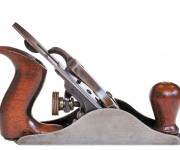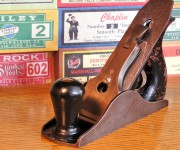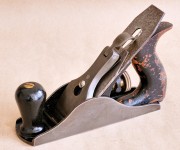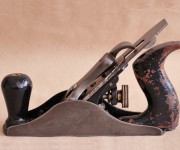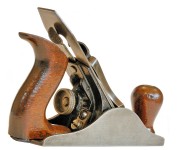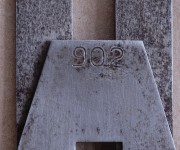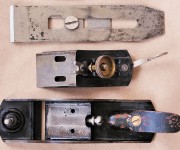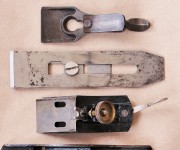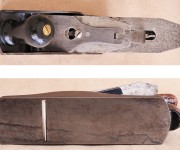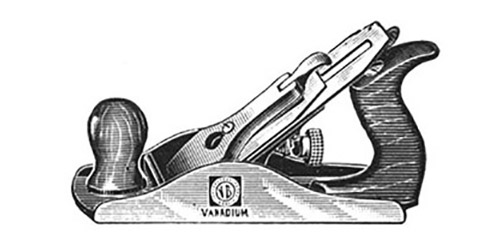
V&B No 902 Smooth Plane
NOTE: Number 3 plane shown.

Refer to the early ‘Uncle Sam’ series of planes and the Series 900 ‘Vanadium’ Bench Planes for a general description of this line.
The Vaughan & Bushnell Number 902 smoothing plane has been a bit of a ‘problem child’ to collectors over the years. Apart from the cutter and cap iron, it does not quite fit neatly into the 900 range as the other planes do. Exceedingly rare, it has never appeared in any known catalog or advertisement, and so dating it has also been problematic.
However the reason for this is quite simple – it doesn’t really exist. Not as an actual 900 series plane anyway.
For a start, all known examples of these planes have been observed as being made from cast iron, rather than drop forged from steel billets. The method of manufacture is (usually) easily determined by the presence of casting voids (bubbles) found on the castings themselves – either under the frog where the bed has been machined, or under the japanning. Though the former is easy enough to spot with a trained eye, the latter can only be seen when the japanning has been worn away in a place where a casting void may be. In other words it would be pure luck to find such voids in this instance.
Another way to determine the construction – albeit a very damaging one – is to lightly grind the metal itself to note the spray pattern and color of the sparks that are emitted. While I do not, in any way, suggest that this be done on an otherwise decent plane, I have had the opportunity to do this on a broken number 902 that came by my way. The mere fact that it was broken in the first place would seem to be an indication that the plane was actually not a number 902 as marked on the capping iron. In the past I have dropped a 905 from a 3rd storey balcony onto concrete without the body breaking, so I can personally attest to Vaughan & Bushnell’s claim that the planes are virtually ‘unbreakable’.
Apart from the cap irons which, as stated earlier, are stamped ‘902’, there are no other identifying marks. To my knowledge the levercaps do not have the number cast into them like other planes in the series, nor is there ‘Drop Forged’ appearing on the toe of the plane – though the space required for such identification on a number 2 sized plane would be, pretty much, non-existant.
Unfortunately, the color of the japanning is not a very reliable indicator. The 900 series planes were initially finished in light gray, before adopting the more traditional black favored by other manufacturers much later on in the production run – sometime in the early 1930’s. However the original series (3, 4, 4½, 5, etc.) ‘Uncle Sam’ planes were all finished in black, as were the cast iron ‘Lincoln’ planes introduced in 1923 (NOTE: The later series ‘Uncle Sam’ planes, introduced in 1926, were drop forged, not cast.)
So where does that leave us as far as the 902 is concerned? Though I haven’t been able to determine the manufacturing dates exactly, I believe the 902 is a rebranded version of an early Number 2 Vaughan & Bushnell plane. While it is known that there are some late model 900 series planes that are actually rebranded 800 series planes – that is they have been cast rather than drop forged – these were all sold off when the company was winding down their hand plane making operations. I do not believe that V&B would introduce an entirely new model on an already diminishing return, however they may have rebranded existing stocks of the older Number 2 planes in much the same way as they did to the others in the range. This would have been done in an effort to try and rid the company of all existing 800 series, and even the older ‘Uncle Sam’ series, stock by rebranding them as the more well known 900’s. I am certainly open to the suggestion that this may be a possibility.
I have been told by other collectors that, by the end of the production run, the company did apparently state that there was a replacement guarantee on all late 900 series planes, should any prove defective or accidentally break – a claim they wouldn’t need to make if they were actually genuine 900 series planes.
It would have been nice to have a genuine Drop Forged 902 plane as part of the lineup, but these smaller planes – in general – are less common amongst the major brands, and so the sales volume for Vaughan & Bushnell were obviously not viable enough for the company to spend money on jigging up for production.
So, with all of this in mind, I believe that the 902 is actually a rebranded number 2 cast iron ‘Uncle Sam’ plane which Vaughan & Bushnell had sold prior to the release of the 1922 catalogue. However, I am more than happy to be proved wrong if new, or opposing, information is presented.


Specifications:

| Plane Type: | Smooth Plane |
| Features: | Adjustable, with screw adjustment for cutter |
| Manufactured: | Unknown, but possibly from c1935 to c1938 |
| Length: | 7 inches |
| Cutter Width: | 1½ inches |
| Construction: | Cast iron body, Walnut handle & knob |
| Finish: | Japanned (black) |
| Price (1922): | N.A. |
| (1923): | N.A. |
| (1927): | N.A. |
| Uses: | General purpose bench plane |

Please check the Value Guide For V&B Planes page for relative prices.


Additional Notes:
The images for this particularly rare model have been sourced from Todd Smith and I’m very grateful to be given permission by him to show them here.



